Today the name Atkins may bring to mind carb-counting and feelings of guilt, but it was once a household name associated with musical virtuosity and countless models of guitars. The reach of Chet Atkins' influence is hard for most young people to understand, given the ongoing lionization of 1970s rock icons. But read interviews with major players today or scour the vintage guitar market, and his name pops up again and again. In fact, just this year you've probably heard Chet's song “Jam Man” dozens of times as the boom-chick riff in the background of those ubiquitous Esurance commercials. Whether you're a collector, a guitarist or both, Chet's legacy on the music industry deserves a closer look.

To better understand Chet Atkins, you have to start with Merle Travis. It was the sound of his characteristic fingerpicking that hooked Chet into the alternating bass, self-accompanied melodies that he became known for. After a stint playing for a radio station with June Carter, Mother Maybelle and the Carter Sisters, he moved to Nashville. There he joined the Grand Ole Opry and eventually started working as a producer with RCA Victor while honing his own sound. Responding to the gaining popularity of rock n' roll, Chet was one of the pioneers of the steel-and-fiddle-lacking “Nashville sound” that today is seen as a turning point in country music.
Chet landed his first hit with “Mr. Sandman,” and his albums quickly gained popularity throughout the 1950s. It was during this time that he became a design consultant for Gretsch and released the first signature models. All the while, Chet continued to produce albums largely self-recorded in his own home. Given his studio prowess, unique solo guitar arrangements and numerous signature models, he eventually earned the nickname Mister Guitar, resulting in an album of the same name.
A high school dropout who was quick to poke fun at himself, Chet decided at one point to give himself the honorary degree of Certified Guitar Player (CGP). This blossomed into something like the equivalent of fingerpicking knighthood, as he bestowed it upon a shortlist of his favorite collaborators. The only other CGPs include Tommy Emmanuel, Jerry Reed, John Knowles, Steve Wariner, Marcel Dadi, and Paul Yandell. Chet's daughter has since retired the title. The complete list of artists who were inspired by and/or collaborated with Atkins is almost too long to list – his career spanned country, rockabilly, classical, jazz and rock – but it's worth noting that Les Paul himself and tone aficionado/virtuoso Eric Johnson number among his most hardcore fans.
As you look over the guitars below and wonder how this humble country boy from Tennessee could have as many signature models as Clapton or Van Halen, keep in mind that Chet won fourteen Grammy awards, was inducted into both the Country Music and Rock and Roll Hall of Fame, and was breaking ground in his home studio a half-century before Garage Band or YouTube even existed.
Chet is one of the few artists who has had signature models across different companies. He had a wide range of models with Gretsch from 1955 to 1980. After the death of Fred Gretsch Jr., Chet partnered with Gibson for the remainder of his career with a signature line focused mostly on electro-acoustic nylon string guitars. In 2007, after Gretsch was acquired by Fender, Chet Atkins' estate allowed Gretsch to use his name again on all the old models. Here's a closer look at the lineage.
The Gretsch Models
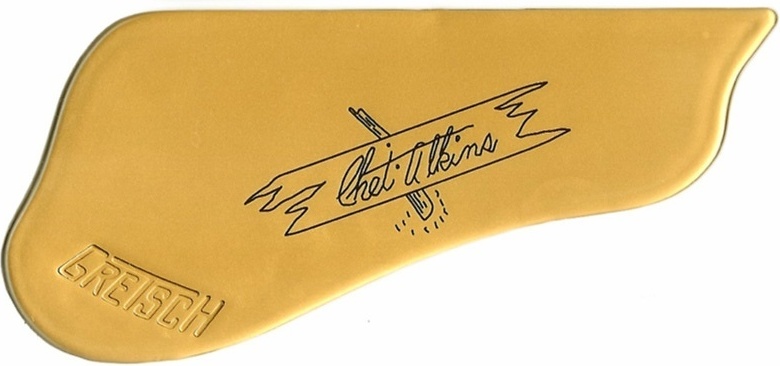
There are four main Chet Atkins models from which numerous variations and reissues are derived. They are (in order of release) the 6120 Chet Atkins Hollow Body (1954), the 6121 Chet Atkins Solid Body (1955), the 6122 Chet Atkins Country Gentleman (1957) and the 6119 Chet Atkins Tennessean (1958). Most of these are distinguished by Chet's signpost insignia on the pickguard.
Production of all but the Solid Body continued after Chet withdrew his endorsement under the names Nashville, Country Classic and Tennessee Rose. The models from 2006 onward use the original names with a G in front of the model number (as do all newer Gretsch models). The Baldwin era saw some interesting though short-lived attempts to attach Chet's name to “modern” guitars.
The Chet Atkins Hollow Body/Nashville
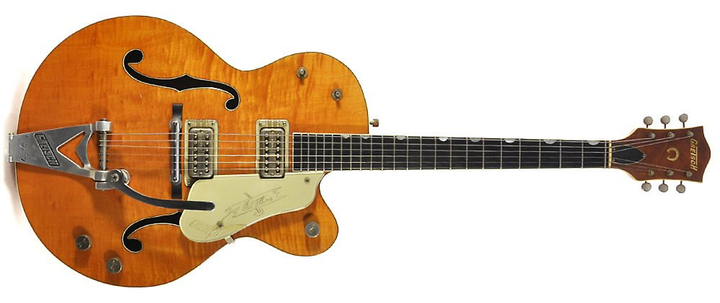
Chet Atkins Hollow Body 6120 (1954-1980)
Single cutaway, Spruce top (1954 only), hollow Maple body with Bigsby tremolo. Deeper than the Country Gentleman with a slightly longer scale. Included two exposed DeArmond pickups. It wasn't saved from the travesty of fake f-holes until 1973.
Chet Atkins Hollow Body G6120 (1991-present)
Single cutaway homage to the original model, though in reality it is semi-hollow body. It is also offered in non-traditional colors with gold hardware.
Chet Atkins 125th Anniversary G6120-125 (2008)
Only 25 examples made. Orange Stain over a Gold Leaf finish, with gold hardware. Came with hand-tooled Anniversary strap and belt buckle.
Chet Atkins Stereo Guitar G6120-CGP (2008-present)
Faux f-holes, custom TV Jones dual coil pickups, Bigsby tremolo tailpiece, and a two-way stereo/mono switch.
Chet Atkins Relic G6120DSW-R (2009)
Only 50 examples made. Distressed vintage orange lacquer finish, aged body binding, branded G on lower bout, stained Maple headstock, Seymour Duncan Dynasonic single coil pickups.
The Chet Atkins Solid Body
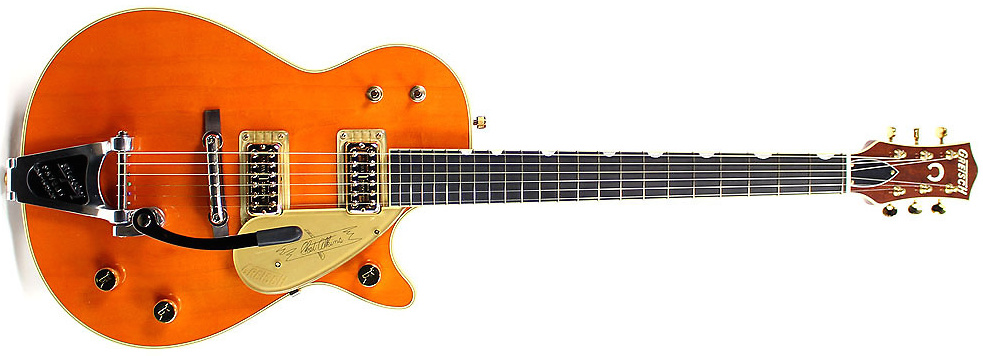
Chet Atkins Solid Body 6121 (1955-1963)
Not as long-lived as its hollow-bodied brothers, it featured a routed Mahogany body, Maple top and DeArmond pickups, it also had appointments such as a “G” branded into the wood of the lower bout and tooled leather side trim.
Chet Atkins Solid Body 1955 Reissue G6121-1955 (2007-present)
After a 34-year absence from the market, Fender-owned Gretsch brought the Solid Body model back with its original specifications (and aged body binding), though it features single coil DynaSonic pickups in lieu of the original DeArmonds.
Chet Atkins Solid Body 1959 Reissue G6121-1959 (2005-present)
This modern reissue stays true to the changes seen in 1959, including a different Bigsby system, Filter'Tron pickups and the introduction of a zero fret. It loses the "G" brand on the lower bout and uses a slightly brighter orange finish.
The Chet Atkins Country Gentleman

Chet Atkins Country Gentleman 6122 (1957-1981)
A thin-bodied (2 inch) Maple hollow body offered in both single or double cutaway models with dual humbuckers. Its 24.5 inch scale put it even shorter than Gibsons at the time. F-holes were usually inlaid, but some were real. Pickup options and Bigsby tailpieces varied over the production run. A 1963 model matching the specs of George Harrison's guitar (in black) is the most valuable specimen.
Chet Atkins Country Gentleman Double Cutaway G6122 (2006-present)
Walnut stain finish, dual Filter'Tron pickups, Bigsby tailpiece. The modern reissue of the original, with an inch longer scale and slightly deeper body. Also available in a 12-string configuration without the Bigsby.
Chet Atkins Country Gentleman 1958 Reissue G6122-1958 (1997-present)
Single cutaway reissue. Pickups, scale length and body depth match the 1958 model.
Chet Atkins Country Gentleman 1959 Reissue G6122-1959 (2003-present)
Single cutaway reissue. Pickups, scale length and body depth match the 1959 model. Also available in left-handed configuration.
Chet Atkins Country Gentleman 1962 Reissue G6122-1962 (current)
Double cutaway reissue. Pickups, scale length and body depth match the 1962 model. Also available in left-handed configuration.
The Chet Atkins Tennessean
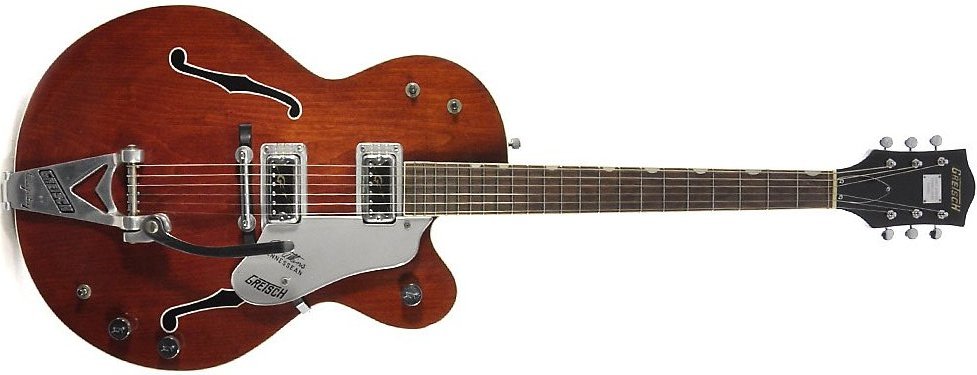
Chet Atkins Tennessean 6119 (1958-1980)
His final lasting signature model, it was renumbered 7655 in 1971 when production moved from New York to Arkansas. A second pickup was added in 1961. Later reissues use the name Tennessee Rose.
Chet Atkins Tennessee Rose G6119 (current)
Available in Dark Cherry Red Stain with Bigsby tremolo and dual humbuckers.
Chet Atkins Tennessee Rose 1959 Reissue G6119-1959 (2007-present)
Single TV Jones pickup, 2.5 inch body depth, slightly narrower bout.
Chet Atkins Tennessee Rose 1962 Reissue G6119-1962 (1994-present)
HiLo'Tron pickups, 2 inch body depth.
Short-lived Chet Atkins Models
Chet Atkins Junior (1970 only)
This was a short-lived single pickup, 23 ¼ inch scale hollow body.

Super Chet 7690 (1972-80)
Truly hollow electric archtop with single rounded cutaway. Its 17 inch wide and 2.5 inch deep body was paired with a longer, Fender-like 25.5 inch scale length and ornate inlays.
Deluxe Chet 7680 (1972-1975)
Same dimensions as the Super Chet with plainer appointments and a stock Bigsby tremolo.
Atkins Axe 7685 (1976-1980)
Aimed at the modern rock guitarist with little input from Chet, this wide yet thin solid body with a Florentine cutaway featured dual DiMarzio humbuckers and quirky dice-shaped inlays. As a result, Chet wanted to call this model the High Roller. Needless to say, management axed that idea.
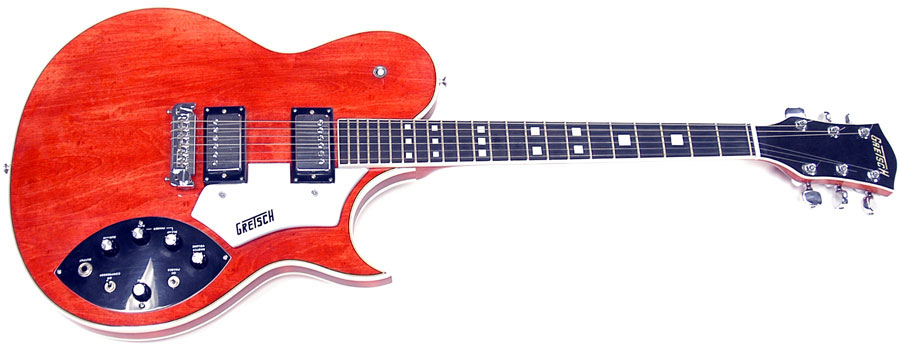
Atkins Super Axe 7680 (1976-1981)
Another oddity among the failures of late 1970s guitar design, this variation on the original Axe included active electronics with an onboard compressor and phaser powered by a nine-volt battery. Specimens with electronics that still work are rare.
The Gibson Models
Chet always wanted to develop an electro-acoustic nylon string guitar. While Gretsch management resisted this in its final years, Gibson obliged. Together they produced three main acoustics – the Chet Atkins CE, the Chet Atkins CEC and the Chet Atkins SST – and continued to produce their own versions of the Country Gentleman and Tennessean through their Custom Line. Despite Gretsch holding the keys to Chet's legacy of electric guitars, two of the rarest and most valuable Chet Atkins models are actually Gibson electrics: the Phasar and the Super 4000. After 2006, the Chet Atkins name was no longer connected to any Gibson model as the rights were returned to Gretsch (owned by Fender).
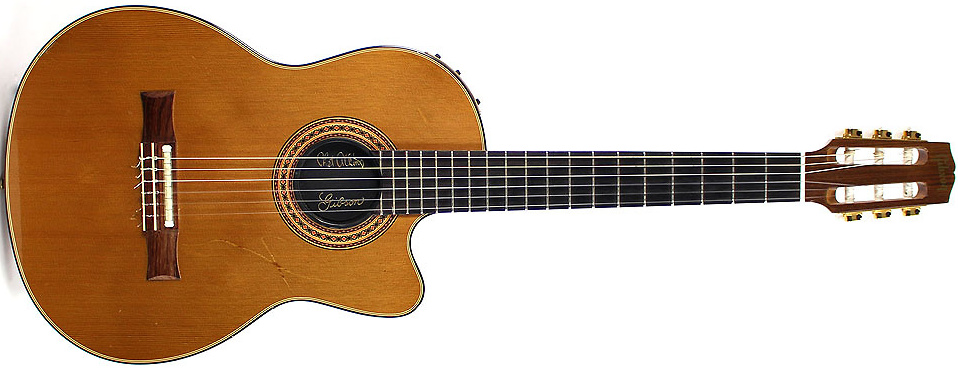
Chet Atkins CE (1981-2005)
Single cutaway chambered electro-acoustic nylon string guitar. Offered with an optional Cedar top from 1999-2002 (known as the True Cedar CE).

Chet Atkins Studio CE (1993-1999, 2004-2005)
Similar to the CE but with a longer 26 inch scale length and no soundhole.
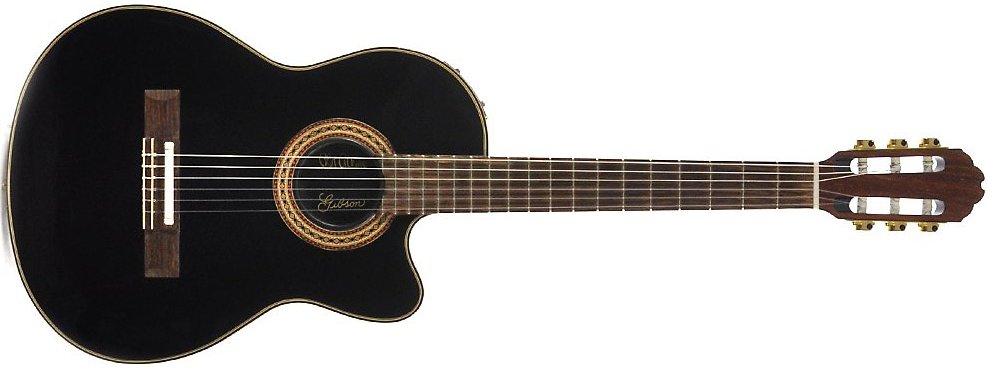
Chet Atkins CEC (1981-2005)
Similar to the CE but with a wider nut tailored to fingerstyle playing. Also offered with an optional Cedar top from 1999-2002 (known as the True Cedar CEC).
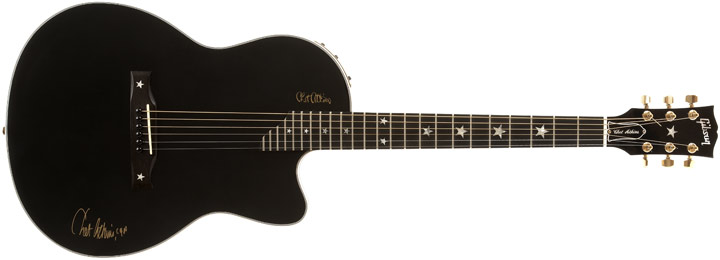
Chet Atkins SST (1987-2005)
A fascinating solid body steel string acoustic design with an onboard pre-amp. Popularized more recently by Dave Matthews, this guitar used a Balsa center block (marketed as Chromyte) with a transducer pickup to achieve its unique sonic quality. Also offered as a 12-string from 1989-1994 and with flamed top for one brief production year (1993-1994).
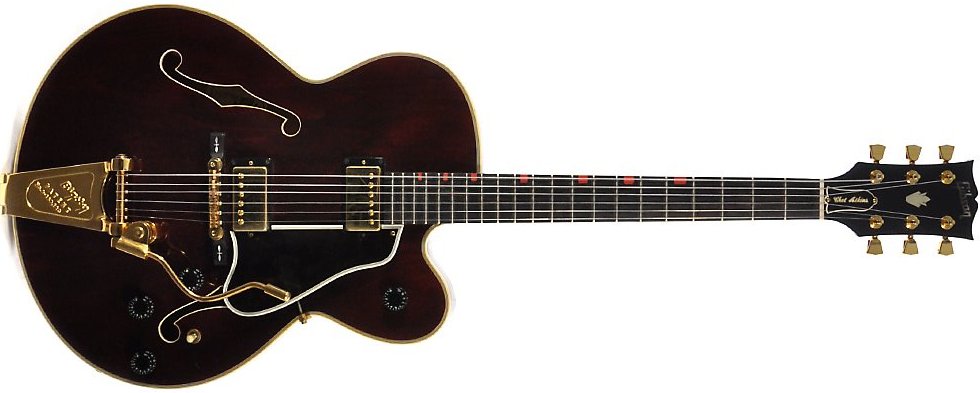
Chet Atkins Country Gentleman (1987-2005)
Mostly true to the Gretsch model, its scale length was a full inch longer and employed traditional humbuckers as opposed to Filter'Trons.
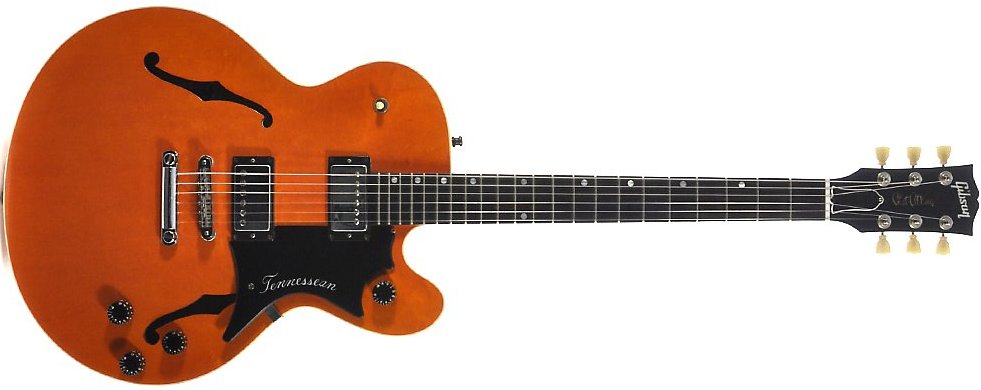
Chet Atkins Tennessean (1987-2005)
Slighty wider and shallower than the Gretsch model with an inch longer scale length. Used a Balsa center block similar to the SST.
Chet Atkins Super 4000 (1997)
Essentially a thinline Super 400 with a floating humbucker and luxurious appointments, only 25 were only produced. Signed and dated by Chet himself, 20 of these were made available to the public. As a result, mint specimens can fetch $25,000 on the market.
Chet Atkins Phasar (1987)
Only six of these were made. Thanks to its one fleeting appearance in the Gibson catalog, it sneaks its way into the “real production guitar” category. The two EMG pickups had an unusual back-shifted position so Chet's thumbpick wouldn't hit either one. Kind of a shame that the onboard phaser clutters the otherwise beautiful offset body.
